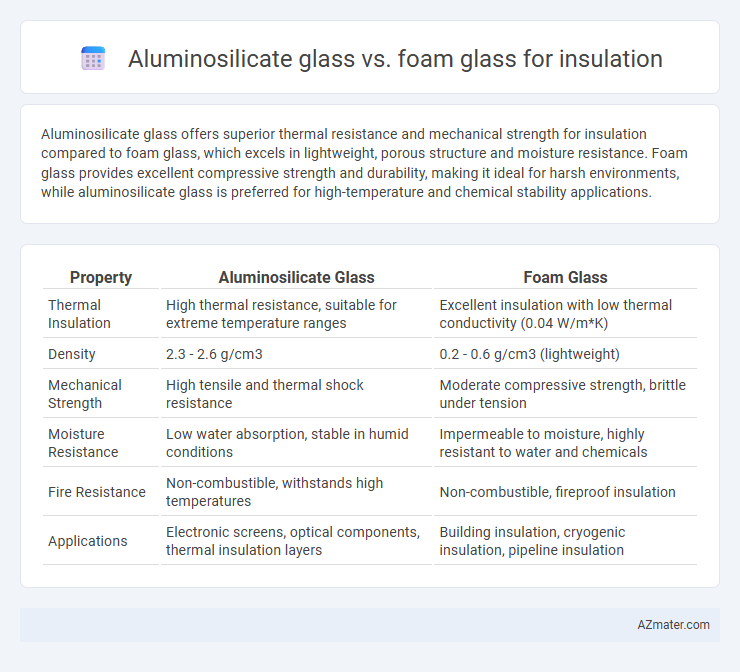Aluminosilicate glass offers superior thermal resistance and mechanical strength for insulation compared to foam glass, which excels in lightweight, porous structure and moisture resistance. Foam glass provides excellent compressive strength and durability, making it ideal for harsh environments, while aluminosilicate glass is preferred for high-temperature and chemical stability applications.
Table of Comparison
| Property | Aluminosilicate Glass | Foam Glass |
|---|---|---|
| Thermal Insulation | High thermal resistance, suitable for extreme temperature ranges | Excellent insulation with low thermal conductivity (0.04 W/m*K) |
| Density | 2.3 - 2.6 g/cm3 | 0.2 - 0.6 g/cm3 (lightweight) |
| Mechanical Strength | High tensile and thermal shock resistance | Moderate compressive strength, brittle under tension |
| Moisture Resistance | Low water absorption, stable in humid conditions | Impermeable to moisture, highly resistant to water and chemicals |
| Fire Resistance | Non-combustible, withstands high temperatures | Non-combustible, fireproof insulation |
| Applications | Electronic screens, optical components, thermal insulation layers | Building insulation, cryogenic insulation, pipeline insulation |
Introduction to Aluminosilicate and Foam Glass Insulation
Aluminosilicate glass insulation is valued for its high thermal stability, excellent mechanical strength, and resistance to chemical corrosion, making it ideal for high-temperature industrial applications. Foam glass insulation, composed of crushed glass and foamed to create a porous structure, offers superior moisture resistance, lightweight properties, and high compressive strength, suitable for building envelope and cryogenic insulation. Both materials provide energy-efficient solutions but differ significantly in thermal conductivity, durability, and environmental resistance.
Composition and Structure Comparison
Aluminosilicate glass is primarily composed of silicon oxide (SiO2), aluminum oxide (Al2O3), and smaller amounts of sodium oxide (Na2O) or potassium oxide (K2O), featuring a dense, amorphous structure that provides high thermal resistance and mechanical strength. Foam glass consists of fine crushed glass fused with a foaming agent such as carbon or other reducing agents, creating a porous, cellular structure with trapped gas bubbles that offer excellent thermal insulation and lightweight properties. The dense network of aluminosilicate glass results in superior durability and thermal stability, whereas the cellular, closed-cell structure of foam glass enhances its insulating performance and compressive strength in industrial insulation applications.
Thermal Insulation Properties
Aluminosilicate glass offers superior thermal insulation with low thermal conductivity typically around 0.03-0.04 W/m*K, making it ideal for high-temperature applications. Foam glass insulation exhibits excellent thermal resistance due to its closed-cell structure, providing conductivity values as low as 0.04 W/m*K and enhanced fire-resistant properties. Both materials deliver efficient thermal insulation, but aluminosilicate glass performs better under extreme heat, while foam glass excels in lightweight, moisture-resistant insulation solutions.
Mechanical Strength and Durability
Aluminosilicate glass exhibits superior mechanical strength due to its dense, non-porous structure and resistance to thermal shock, making it highly durable for insulation applications in harsh environments. Foam glass, while offering excellent thermal insulation and lightweight properties, has a cellular structure that results in lower compressive strength and susceptibility to mechanical damage under heavy loads. Durability of aluminosilicate glass surpasses foam glass in moisture resistance and long-term structural integrity, ensuring enhanced performance in demanding insulation scenarios.
Moisture and Chemical Resistance
Aluminosilicate glass exhibits excellent moisture resistance due to its dense, non-porous structure, making it highly effective in preventing water absorption and chemical degradation in insulation applications. Foam glass, while also resistant to many chemicals, features a cellular structure that can trap moisture if not properly sealed, potentially reducing its insulation performance over time. Both materials offer strong chemical resistance, but aluminosilicate glass provides superior long-term durability against harsh environmental conditions and corrosive substances.
Fire and Heat Resistance
Aluminosilicate glass exhibits superior fire and heat resistance due to its high melting point around 1,700degC, making it ideal for extreme temperature insulation applications. Foam glass, composed of crushed glass with cellular structure, provides excellent thermal insulation but has a lower maximum service temperature near 650degC. Fire-resistant performance of aluminosilicate glass surpasses foam glass, which is more suited for moderate heat insulation and fire barrier roles.
Environmental Impact and Sustainability
Aluminosilicate glass and foam glass both offer significant benefits for insulation with distinct environmental impacts. Aluminosilicate glass, highly durable and recyclable, reduces waste and lowers energy consumption during production due to its high thermal resistance and long lifespan. Foam glass, created from recycled glass materials, features excellent thermal insulation and moisture resistance while being non-toxic and fully recyclable, making it a sustainable choice that minimizes landfill contributions and reduces carbon footprint.
Installation and Application Methods
Aluminosilicate glass insulation is typically installed using blown-in or spray-on application methods, allowing for seamless coverage in complex structures and high thermal resistance in industrial environments. Foam glass insulation, made from crushed recycled glass, is installed as rigid panels or blocks, offering superior compressive strength and moisture resistance ideal for exterior foundations and underground pipelines. Both materials require specialized handling; aluminosilicate glass demands protective gear due to fine particulate matter, while foam glass panels necessitate precise cutting and sealing for airtight installation.
Cost and Lifespan Analysis
Aluminosilicate glass offers higher durability and thermal resistance, leading to a longer lifespan typically exceeding 30 years, while foam glass insulation generally lasts around 20 years but boasts superior compressive strength and moisture resistance. Cost-wise, foam glass tends to be more expensive upfront due to its specialized manufacturing process, but its low maintenance and enhanced insulating properties can justify the investment in industrial applications. Aluminosilicate glass provides a cost-effective solution with moderate longevity, making it suitable for residential insulation where initial budget constraints are a priority.
Choosing the Best Glass Insulation for Your Needs
Aluminosilicate glass offers superior thermal resistance and durability, making it ideal for high-temperature insulation applications and environments requiring chemical stability. Foam glass insulation provides excellent compressive strength, moisture resistance, and lightweight properties, suitable for structural insulation and damp conditions. Selecting the best glass insulation depends on specific needs such as temperature range, mechanical load, and exposure to moisture or chemicals.

Infographic: Aluminosilicate glass vs Foam glass for Insulation
 azmater.com
azmater.com